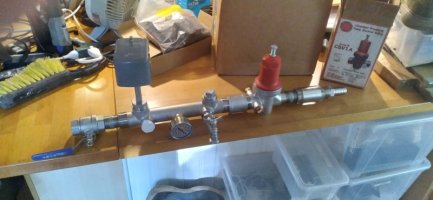Hi I just finished installing a new replacement 2-wire submersible pump and it won't start. It's a 230v 3/4hp Red Lion pump which has a franklin electric motor.
I'm getting voltage Ok to the pump, measured at the pressure switch.
Line to Line resistance between power wires is 4ohms, measured at the pressure switch, and then at the well head. The spec sheets says this should be 3.0-3.6ohms. There's about 100 ft of wire to the pump.
A bigger issue seems to be the Line to Ground resistance, which measures about 120kohm from either power wire to ground. I measured this at the pressure switch, then I measured it at the well head by cutting the freshly spliced wires. I re-used the existing wire which looked ok as far as I could tell.
I know I should have thoroughly tested the wires and pump before dropping it in, but I didn't. Duh. Before I pull the pump again to check the wires and splices and test the new pump properly, does anyone have a good idea of what's probably wrong?
---------------------------------------
Here's an update later in the day: It turns out the pump actually does turn on and pumps, but there appears to be a clog in the output pipe to the house where I repaired a break. I might have forgotten to remove a piece of rag I used to keep dirt out. Haven't backfilled yet, thankfully.
But I'm still puzzled by the 120kohm reading from the power wires to ground. Is this normal? I thought it should be very high resistance especially on a new pump. Anyone have advice?
I'm getting voltage Ok to the pump, measured at the pressure switch.
Line to Line resistance between power wires is 4ohms, measured at the pressure switch, and then at the well head. The spec sheets says this should be 3.0-3.6ohms. There's about 100 ft of wire to the pump.
A bigger issue seems to be the Line to Ground resistance, which measures about 120kohm from either power wire to ground. I measured this at the pressure switch, then I measured it at the well head by cutting the freshly spliced wires. I re-used the existing wire which looked ok as far as I could tell.
I know I should have thoroughly tested the wires and pump before dropping it in, but I didn't. Duh. Before I pull the pump again to check the wires and splices and test the new pump properly, does anyone have a good idea of what's probably wrong?
---------------------------------------
Here's an update later in the day: It turns out the pump actually does turn on and pumps, but there appears to be a clog in the output pipe to the house where I repaired a break. I might have forgotten to remove a piece of rag I used to keep dirt out. Haven't backfilled yet, thankfully.
But I'm still puzzled by the 120kohm reading from the power wires to ground. Is this normal? I thought it should be very high resistance especially on a new pump. Anyone have advice?
Last edited:




